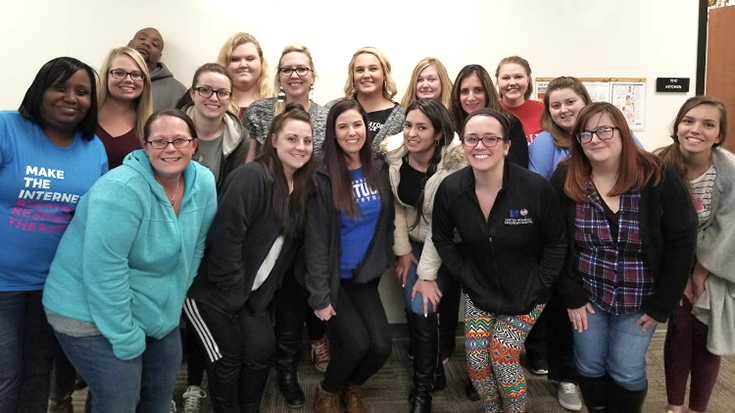
Kyle Mahan, MS, RRT, is the director of clinical education at Jefferson Community and Technical College in Louisville, KY. This past fall he led his students on a new endeavor: the original research project. Mahan describes this project as a “fun and effective” way to introduce his students into research, and it proved to be successful as well. In fact, Mahan’s students look forward to the chance to present their project board at a state conference. We asked Mahan to share details about this class project and to offer tips for educators and mentors interested in pursuing a similar effort with their students.
Getting started
“Over the summer in prepping for the semester, I thought it would be more impactful, and, to be honest, more fun to do a research project rather than having the students read other scholarly articles and write a summary of other people’s finding,” Mahan said.
Mahan worked with Mary Beth Keffer, RRT program director, and Dr. Brittany Inge, director of institutional research for Jefferson Community and Technical College to help make this an effective and impactful experience for the students.
Higher-level work
Mahan and his students looked at the habits and perceptions of smoking traditional tobacco cigarettes and electronic cigarettes.
“At first, there was little enthusiasm about what they were doing, but once they finished their portions and we got the data back, you could see more and more students thinking that this was interesting and cool,” Mahan said.
In addition to conducting and organizing the research, the students appreciated comparing their papers to those they read for the literature review and discussion areas of their project.
“Their paper looks a lot like these advanced and published research articles, and it was exciting to let them know the body of work they completed is on par with graduate level work they can expect as they advance and continue their education,” Mahan said. “They now know they can do it.”
Student-produced
The students took complete ownership of this project.
“I aided them and helped with format and editing,” Mahan said. “Because the desire was to be done in a semester, I handled the institutional research approval myself and came up with a general topic idea that they formalized and developed.”
Once the project kicked off, responsibilities were split among the 18 second year students, dividing them into teams. This helped make the time commitment manageable and instilled teamwork.
Responsibilities:
- One team wrote the introduction and literature review.
- The class decided on the problem statement and research questions.
- Three students collected the data on campus and another team went to Dr. Inge’s office in institutional research to run the data and develop results.
- A couple of students made brochures to give to participants about smoking cessation options and sources to reach out to encourage them to quit smoking.
- Another group interpreted the data, writing a summary explanation.
- Lastly, a team wrote the discussion, limitations and suggestions for future research.
The college made a poster and to prominently display in the health science building.
Up to the challenge
“This is an exceptional group of students,” Mahan said. “They have immense grit and determination to succeed.”
Mahan has already seen a shift in self-confidence in his students as they’ve progressed through the RT program. He continually points out parallels to his students of their work and what they would experience in high level educational institutions. For example, the class took part in online discussion boards and writing and Mahan later told them that is what they will do in a bachelor’s program.
“Now they know they can do it,” Mahan said.
Toward the end of the research project, Mahan let his students know that their work is exactly what they will do as a capstone paper for a graduate in public health or similar field of study.
For Mahan, seeing his students “realize they can and just did graduate level work as a team is deeply gratifying for a college instructor.”
“I am not sure how inspired they were, but I know they inspired me,” Mahan said.
Student Reflections
This research project opportunity helped the students think more about public health issues, which was a shift from their standard bedside focus.
“It was very interesting for me to see how students view smoking cigarettes and electronic cigarettes,” said Delane Morrow, student.
“What I liked best was the opportunity to explore alternative avenues and care paths that respiratory therapists can take other than direct patient care,” said Sarah Pontrich, student.
Next Steps
This unified class project was inspired by CoArc’s desire for programs to introduce students to scholarly research, and Mahan hopes to continue conducting this research opportunity for his students.
“It is our goal to be able to do this each fall with the second year students,” Mahan said. “Nothing too complex, but something that contributes to the body of knowledge at the school.”